Cover
Notice
How to Use This Manual
Table of Contents
CHAPTER 1 OVERVIEW
1.1 V850E3v5 Architecture Features
1.1.1 Multi-processing environment
1.1.2 Virtual machines
1.1.3 Hardware multithreading
1.2 V850E3v5 Architecture Class
(1) V850E3v5-F: Prioritizes functionality
(2) V850E3v5-V: Provides a balance between functionality and cost
(3) V850E3v5-S: Prioritizes cost
1.3 Changes from the V850E2v3 Architecture
CHAPTER 2 PROCESSOR MODEL
2.1 Resource Management
2.2 CPU Operating Modes
2.2.1 Definition of CPU operating modes
2.2.2 CPU operating mode transition
2.2.3 CPU operating modes and privileges
2.3 Hardware Thread
2.3.1 Thread status
2.3.2 Stopping a thread by executing the HALT instruction
2.3.3 Pausing a thread by executing the SNOOZE instruction
2.4 Instruction Execution
2.5 Exceptions and Interrupts
2.5.1 Types of exceptions
2.5.2 Exception level
2.6 Coprocessors
2.6.1 Coprocessor use permissions
2.6.2 Correspondences between coprocessor use permissions and coprocessors
2.6.3 Coprocessor unusable exceptions
2.6.4 System registers
2.7 Registers
2.7.1 Program registers
2.7.2 System registers
2.7.3 Register updating
2.7.4 Accessing undefined registers
2.8 Data Types
2.8.1 Data formats
2.8.2 Data representation
2.8.3 Data alignment
2.9 Address Space
2.9.1 Memory map
2.9.2 Instruction addressing
2.9.3 Data addressing
2.10 Acquiring the CPU Number
2.11 System Protection Identifier
CHAPTER 3 REGISTER REFERENCE
3.1 Program Registers
3.1.1 General-purpose registers
3.1.2 PC - Program counter
3.2 Basic System Registers
3.2.1 Basic registers (specific to hardware threads)
(1) EIPC - Status save register when acknowledging EI level exception
(2) EIPSW - Status save register when acknowledging EI level exception
(3) FEPC - Status save register when acknowledging FE level exception
(4) FEPSW - Status save register when acknowledging FE level exception
(5) PSW - Program status word
(6) EIIC - EI level exception cause
(7) FEIC - FE level exception cause
(8) CTPC - Status save register when executing CALLT
(9) CTPSW - Status save register when executing CALLT
(10) CTBP - CALLT base pointer
(11) ASID - Address space ID
(12) EIWR - EI level exception working register
(13) FEWR - FE level exception working register
(14) HTCFG0 - Thread configuration register
(15) MEA - Memory error address register
(16) MEI - Memory error information register
3.2.2 Basic registers (specific to virtual machines)
(1) RBASE - Reset vector base address
(2) EBASE - Exception handler vector address
(3) INTBP - Base address of the interrupt handler table
(4) PID - Processor ID
(5) SCCFG - SYSCALL operation setting
(6) SCBP - SYSCALL base pointer
(7) MCFG0 - Machine configuration
(8) MCFG1 - Machine configuration
(9) MCTL - Machine control
3.3 Interrupt Function Registers
3.3.1 Interrupt Function System Registers
(1) FPIPR - FPI exception interrupt priority setting
(2) ISPR - Priority of interrupt being serviced
(3) PMR - Interrupt priority masking
(4) ICSR - Interrupt control status
(5) INTCFG - Interrupt function setting
3.4 Hardware Thread Function Registers
3.4.1 Hardware thread control system registers
(1) TCSEL - Hardware thread selection
(2) HTCTL - Hardware thread control
(3) HTSCCTL - Hardware thread schedule setting
(4) HTSCTBLn - Hardware thread schedule table (n = 0 to 7)
3.5 Virtualization Support Function Registers
3.5.1 Virtual machine control registers
(1) VCSEL - Virtual machine context selection
(2) HVCCFG - HVCALL configuration
(3) HVCBP - HVCALL base pointer
(4) VMPRTn - Assignment to a hardware thread (n = 0 to 2)
(5) VMSCCTL - Virtual machine hardware schedule
(6) VMSCTBLn - Virtual machine schedule table setting (n = 0 to 3)
3.6 FPU Function Registers
3.6.1 Floating-point operation registers
3.6.2 Floating-point system registers
(1) FPSR - Floating-point configuration/status
(2) FPEPC - Floating-point exception program counter
(3) FPST - Floating-point operation status
(4) FPCC - Floating-point operation comparison result
(5) FPCFG - Floating-point operation configuration
(6) FPEC - Floating-point exception control
3.7 SIMD Function Registers
3.7.1 Vector registers
3.7.2 SIMD function system registers
(1) SESR - SIMD operation settings and status
3.8 MMU Function Registers
3.8.1 MMU Function System Registers
(1) TLBSCH - TLB search
(2) TLBIDX - TLB operation target index
(3) TELO0 - TLB entry Lo access 0
(4) TELO1 - TLB entry Lo access 1
(5) TEHI0 - TLB entry Hi access 0
(6) TEHI1 - TLB entry Hi access 1
(7) TLBCFG - TLB configuration
3.9 MPU Function Registers
3.9.1 MPU Function System Registers
(1) MPM - Memory protection operation mode
(2) MPRC - MPU region control
(3) MPBRGN - MPU base region
(4) MPTRGN - MPU end region
(5) MCA - Memory protection setting check address
(6) MCS - Memory protection setting check size
(7) MCC - Memory protection setting check command
(8) MCR - Memory protection setting check result
(9) MPPRTn - Protection area assignment
(10) MPLAn - Protection area minimum address
(11) MPUAn - Protection area maximum address
(12) MPATn - Protection area attribute
3.10 Cache Operation Function Registers
3.10.1 Cache Control Function System Registers
(1) ICTAGL - Instruction cache tag Lo access
(2) ICTAGH - Instruction cache tag Hi access
(3) ICDATL - Instruction cache data Lo access
(4) ICDATH - Instruction cache data Hi access
(5) DCTAGL - Data cache tag Lo access
(6) DCTAGH - Data cache tag Hi access
(7) DCDATL - Data cache data Lo access
(8) DCDATH - Data cache data Hi access
(9) ICCTRL - Instruction cache control
(10) DCCTRL - Data cache control
(11) ICCFG - Instruction cache configuration
(12) DCCFG - Data cache configuration
(13) ICERR - Instruction cache error
(14) DCERR - Data cache error
(15) BWERRL - Bus write access error Lo
(16) BWERRH - Bus write access error Hi
(17) BRERRL - Bus read access error Lo
(18) BRERRH - Bus read access error Hi
SECTION 4 CPU VIRTUALIZATION SUPPORT FUNCTION
(1) CPU virtualization
(2) Memory virtualization
(3) Linkage to hardware multithreading
(4) Virtual machine schedule function
4.1 Configuration of CPU Virtualization Support Function
4.1.1 Hypervisor and virtual machines
4.1.2 Virtual machine mode
4.1.3 Native machine and virtual machines
4.2 Control of CPU Virtualization Support Function
4.3 Resource Management
4.3.1 Machine context
4.3.2 Hypervisor privilege
4.3.3 Machine context operation method
4.3.4 Acquiring the number of virtual machine contexts
4.3.5 Acquiring the virtual machine number
4.3.6 Virtual machine system protection identifier
4.3.7 Memory virtualization
(1) MMU supporting virtualization
(2) Memory resource address translation
4.4 Operation Model
4.4.1 Coordination with hardware multithreading
4.4.2 Structuring the virtual machines
4.4.3 Changing to native mode
4.4.4 Interrupts
4.4.5 Calling the hypervisor
(1) Hypervisor trap
(2) Hypervisor call
4.4.6 Interface with the hypervisor
(1) Utilization of the HVCALL instruction
(2) Stepwise use of the HVTRAP instruction
(3) Virtual machine for which hypervisor services are prohibited
4.5 Instructions
4.5.1 HVTRAP instruction
4.5.2 HVCALL instruction
4.5.3 LDVC/STVC instruction
4.6 Cautions on Using Virtual Machines
4.6.1 Logical partitioning-related differences between hardware threads and by virtual machines
(1) Protection of thread contexts among virtual machines
(2) CPU time schedule
(3) Logical partitioning by virtual machine context
4.6.2 Standalone use with CPU virtualization support function
4.6.3 Differences from physical multi-processor system
(1) CPU time schedule
(2) Sharing of the hardware functions of the CPU core
CHAPTER 5 HARDWARE MULTITHREADING FUNCTION
(1) Thread scheduler
(2) Thread interrupt response
(3) Thread control instructions
(4) CPU virtualization and affinity
5.1 Configuration of Hardware Multithreading Function
5.1.1 Scheduler and thread contexts
5.1.2 Virtualization support function and hardware threads
(1) Resource sharing between the native thread and thread #0
(2) Logical partitioning of thread contexts
5.2 Control of Hardware Thread Function
5.3 Resource Management
5.3.1 Thread contexts
5.3.2 Thread context operation method
5.3.3 Acquiring the number of built-in hardware threads
5.3.4 Acquiring the thread number
5.3.5 Multi-thread execution status and single-thread execution status
5.4 Operation Model
5.4.1 Starting thread execution
(1) Enabling hardware threads
(2) Setting up the thread execution schedule
(3) Setting up interrupts
(4) Transition to the multi-thread execution status
5.4.2 Stopping thread execution
(1) Transition to the single-thread execution status
(2) Disabling hardware threads
(3) Setting up the multi-thread execution schedule
(4) Releasing thread interrupts
(5) Transition to the multi-thread execution status
5.4.3 Exceptions and interrupts
(1) Exceptions related to instruction execution
(2) Exceptions for which the thread cannot be identified
(3) Interrupts
5.4.4 Exception and interrupt servicing thread independence
5.4.5 Parallel programming and inter-thread communication
5.5 Instructions
(1) Thread control instructions
(2) Thread context operation instructions
5.5.1 EST/DST instruction
5.5.2 HALT instruction
5.5.3 SNOOZE instruction
5.5.4 LDTC/STTC instruction
5.6 Scheduling
5.6.1 Multi-level scheduling
(1) Native mode
(2) Virtual machine mode
5.6.2 Schedule switching opportunities
(1) Transition to the native mode
(2) Transition to the single-thread execution status
5.6.3 Virtual machine schedule method
(1) Table schedule method
(2) Other schedule methods
5.6.4 Thread schedule method
(1) Table schedule method
(2) Other schedule methods
5.6.5 Relationship between virtual machine schedule and thread schedule
5.6.6 Operation when a scheduled thread cannot be executed
5.6.7 Exception acknowledgment
CHAPTER 6 EXCEPTIONS AND INTERRUPTS
6.1 Outline of Exceptions
6.1.1 Exception cause list
6.1.2 Overview of exception causes
(1) RESET and VMRESTART
(2) FENMI, FEINT, and EIINT
(3) SYSERR
(4) FPI and FPP
(5) MIP and MDP
(6) ITLBE and DTLBE
(7) RIE
(8) PIE
(9) UCPOP
(10) MAE
(11) TRAP, FETRAP, SYSCALL, HVCALL, and HVTRAP
6.1.3 Types of exceptions
(1) Terminating exceptions
(2) Resumable exceptions
(3) Pending exceptions
6.1.4 Exception acknowledgment conditions and priority order
6.1.5 Interrupt exception priority and priority masking
(1) Interrupt priority
(2) Interrupt priority mask
(3) Differences in operation between EIINTn and FPI
6.1.6 Return and restoration
6.1.7 Context saving
(1) Saving destination
(2) Context saving
6.2 Operation When Acknowledging an Exception
6.2.1 Special operations
(1) HVTRAP instruction
(2) Operational differences due to interrupt bind settings
(3) EP bit of PSW register
(4) Coprocessor unusable exception
(5) Reserved instruction exception
(6) Reset/virtual machine restart
6.3 Return from Exception Handling
6.4 Exception Management
6.4.1 Exception synchronization instruction
6.4.2 Checking and canceling pending exception
6.5 Exception Handler Address
6.5.1 Resets, exceptions, and interrupts
(1) Direct vector method
(2) Table reference method
6.5.2 System calls and hypervisor calls
(1) System calls
(2) Hypervisor calls
6.5.3 Base register restrictions
6.5.4 Models for application
CHAPTER 7 MEMORY MANAGEMENT
7.1 Memory Management Unit (MMU)
7.1.1 Features
(1) Virtual memory function
(2) Memory protection function
(3) Virtual machine support
7.1.2 Translation Lookaside Buffer (TLB)
(1) TLB entry format
7.1.3 Memory management registers
7.1.4 TLB instructions
(1) TLBR instruction
(2) TLBW instruction
(3) TLBS instruction
(4) TLBVI instruction
(5) TLBAI instruction
7.1.5 TLB exception
(1) Identification of TLB exception causes
(2) TLB exceptions in instructions in which memory access occurs several times during execution
(3) TLB exception in a cache operation instruction
7.1.6 Translation from virtual address to physical address
7.1.7 Address space
7.1.8 Use of MMU in virtual machine mode
(1) Address space for hypervisor call
7.1.9 Real addressing mode
(1) Real addressing mode for virtual machines
(2) Transition to read addressing mode
(3) When bit width differs between virtual address and physical address
7.1.10 Support of page sizes less than 4 KB
7.1.11 Avoidance of the synonym problem
7.2 Memory Protection Unit (MPU)
7.2.1 Features
(1) Memory access control
(2) Access management for each CPU operation mode
(3) Virtual machine support
7.2.2 Register set
7.2.3 MPU operation settings
(1) Settings for native mode
(2) Settings for virtual machine mode
7.2.4 Protection area settings
(1) Determination of protection area available for use by virtual machines
(2) Protection area settings
7.2.5 Caution points for protection area setup
(1) Crossing protection area boundaries
(2) Invalid protection area settings
(3) Invalidation of protection during HVCALL execution
7.2.6 Access control
7.2.7 Violations and exceptions
(1) Execution protection violation (MIP exception)
(2) Data protection violation (MDP exception)
(3) Exception cause code and exception address
7.2.8 Memory protection setting check function
(1) Procedure
(2) Sample code
7.3 Slave Address Translation Function
7.4 Cache
7.4.1 Cache operation registers
7.4.2 Change cache use mode
(1) Change use mode of instruction cache
(2) Change use mode of data cache
7.4.3 Cache operations using CACHE instruction
(1) Specification method for target of CACHE instruction
(2) Operations performed using the CACHE instruction
7.4.4 Cache operation when the PREF instruction is executed
7.4.5 Cache index specification method
7.4.6 Execution privilege of the CACHE/PREF instruction
7.4.7 Memory protection for CACHE and PREF instructions
7.4.8 Example of cache memory operation using CACHE instruction
7.4.9 Cache parity protection function
7.5 Mutual Exclusion
7.5.1 Shared data that does not require mutual exclusion processing
7.5.2 Performing mutual exclusion by using the LDL.W and STC.W instructions
(1) Link
(2) Sample code
7.5.3 Performing mutual exclusion by using the SET1 instruction
(1) Sample code
7.5.4 Performing mutual exclusion by using the CAXI instruction
(1) Sample code
CHAPTER 8 COPROCESSOR
8.1 Floating-Point Operation
8.1.1 Configuration of CPU floating -point operation function
(1) Not implemented
(2) Implementing only single precision
(3) Implementing single precision and double precision
8.1.2 FPU version
8.1.3 Data types
(1) Floating-point format
(2) Fixed-point formats
(3) Expanded floating-point format [FPU-3.0]
8.1.4 Register set
(1) Floating-point system registers
8.1.5 Floating-point instructions
8.1.6 Floating-point operation exceptions
(1) Types of exceptions
(2) Exception handling
8.1.7 Exception details
(1) Inexact exception (I)
(2) Invalid operation exception (V)
(3) Division by zero exception (Z)
(4) Overflow exception (O)
(5) Underflow exception (U)
(6) Unimplemented operation exception (E)
8.1.8 Precise exceptions and imprecise exceptions
(1) Precise exceptions
(2) Imprecise exceptions
8.1.9 Saving and returning status
8.1.10 Flushing subnormal numbers
(1) Normalize the subnormal numbers and continue executing arithmetic processing
(2) Generate an unimplemented operation exception (E) and execute exception handling
(3) Instructions that can handle subnormal numbers
(4) Instructions that are not affected by flushing subnormal numbers
8.1.11 Selection of floating-point operation model
(1) Do not generate exceptions model
(2) Imprecise exception model
(3) Precise exception model
8.1.12 Flush to nearest [FPU-3.0]
8.2 Fixed-Point SIMD
8.2.1 Features
(1) Parallel processing performance
(2) Memory access functions
(3) Instructions suitable for various application fields
8.2.2 Implementation of SIMD operation function
8.2.3 Data types
(1) 8-bit data format
(2) 16-bit data format
(3) 32-bit data format
(4) 64-bit data format
(5) Range and precision of fixed-point data types
8.2.4 Saturation
(1) 16-bit signed saturation
(2) 32-bit signed saturation
8.2.5 Rounding
(1) Normal rounding
8.2.6 Extension of significant digits for intermediate results
8.2.7 Register set
8.2.8 SIMD instructions
CHAPTER 9 INSTRUCTION REFERENCE
9.1 Opcodes and Instruction Formats
9.1.1 CPU instructions
(1) reg-reg instruction (Format I)
(2) imm-reg instruction (Format II)
(3) Conditional branch instruction (Format III)
(4) 16-bit load/store instruction (Format IV)
(5) Jump instruction (Format V)
(6) 3-operand instruction (Format VI)
(7) 32-bit load/store instruction (Format VII)
(8) Bit manipulation instruction (Format VIII)
(9) Extended instruction format 1 (Format IX)
(10) Extended instruction format 2 (Format X)
(11) Extended instruction format 3 (Format XI)
(12) Extended instruction format 4 (Format XII)
(13) Stack manipulation instruction format (Format XIII)
(14) Load/store instruction 48-bit format (Format XIV)
9.1.2 Coprocessor instructions
(1) Coprocessor unusable exception
9.1.3 Reserved instructions
9.2 Basic Instructions
9.2.1 Overview of basic instructions
(1) Load instructions
(2) Store instructions
(3) Multiply instructions
(4) Multiply-accumulate instructions
(5) Arithmetic instructions
(6) Conditional arithmetic instructions
(7) Saturated operation instructions
(8) Logical instructions
(9) Data manipulation instructions
(10) Bit search instructions
(11) Divide instructions
(12) High-speed divide instructions
(13) Branch instructions
(14) Loop instruction
(15) Bit manipulation instructions
(16) Special instructions
9.2.2 Basic instruction set
ADD
ADDI
ADF
AND
ANDI
Bcond
BINS
BSH
BSW
CALLT
CAXI
CLL
CLR1
CMOV
CMP
CTRET
DI
DISPOSE
DIV
DIVH
DIVHU
DIVQ
DIVQU
DIVU
EI
EIRET
FERET
FETRAP
HALT
HSH
HSW
JARL
JMP
JR
LD.B
LD.BU
LD.DW
LD.H
LD.HU
LD.W
LDL.W
LDSR
LOOP
MAC
MACU
MOV
MOVEA
MOVHI
MUL
MULH
MULHI
MULU
NOP
NOT
NOT1
OR
ORI
POPSP
PREPARE
PUSHSP
RIE
ROTL
SAR
SASF
SATADD
SATSUB
SATSUBI
SATSUBR
SBF
SCH0L
SCH0R
SCH1L
SCH1R
SET1
SETF
SHL
SHR
SLD.B
SLD.BU
SLD.H
SLD.HU
SLD.W
SNOOZE
SST.B
SST.H
SST.W
ST.B
ST.DW
ST.H
ST.W
STC.W
STSR
SUB
SUBR
SWITCH
SXB
SXH
SYNCE
SYNCI
SYNCM
SYNCP
SYSCALL
TRAP
TST
TST1
XOR
XORI
ZXB
ZXH
9.3 Virtualization Support Instructions
9.3.1 Overview of virtualization support instructions
9.3.2 Virtualization support instruction set
HVCALL
HVTRAP
LDVC.SR
STVC.SR
9.4 Hardware Multithreading Instructions
9.4.1 Overview of hardware multithreading instructions
9.4.2 Hardware multithreading instruction set
DST
EST
LDTC.{GR,VR,PC}
LDTC.SR
STTC.{GR,VR,PC}
STTC.SR
9.5 Cache Instructions
9.5.1 Overview of cache instructions
9.5.2 Cache instruction set
CACHE
PREF
9.6 MMU Control Instructions
9.6.1 Overview of MMU control instructions
9.6.2 MMU control instruction set
TLBAI
TLBR
TLBS
TLBVI
TLBW
9.7 Debug Instructions
9.7.1 Overview of debug instructions
9.7.2 Debug instruction set
DBCP
DBHVTRAP
DBPUSH
DBRET
DBTAG
DBTRAP
RMTRAP
9.8 Floating-Point Instructions
9.8.1 Instruction formats
(1) Format F:I
9.8.2 Overview of floating-point instructions
(1) Basic operation instructions
(2) Extended basic operation instructions
(3) Conversion instructions
(4) Comparison instructions
(5) Conditional move instructions
(6) Condition bit transfer instruction
9.8.3 Conditions for comparison instructions
9.8.4 Floating-point instruction set
ABSF.D
ABSF.S
ADDF.D
ADDF.S
CEILF.DL
CEILF.DUL
CEILF.DUW
CEILF.DW
CEILF.SL
CEILF.SUL
CEILF.SUW
CEILF.SW
CMOVF.D
CMOVF.S
CMPF.D
CMPF.S
CVTF.DL
CVTF.DS
CVTF.DUL
CVTF.DUW
CVTF.DW
CVTF.HS [FPU-3.0]
CVTF.LD
CVTF.LS
CVTF.SD
CVTF.SL
CVTF.SH [FPU-3.0]
CVTF.SUL
CVTF.SUW
CVTF.SW
CVTF.ULD
CVTF.ULS
CVTF.UWD
CVTF.UWS
CVTF.WD
CVTF.WS
DIVF.D
DIVF.S
FLOORF.DL
FLOORF.DUL
FLOORF.DUW
FLOORF.DW
FLOORF.SL
FLOORF.SUL
FLOORF.SUW
FLOORF.SW
FMAF.S [FPU-3.0]
FMSF.S [FPU-3.0]
FNMAF.S [FPU-3.0]
FNMSF.S [FPU-3.0]
MAXF.D
MAXF.S
MINF.D
MINF.S
MULF.D
MULF.S
NEGF.D
NEGF.S
RECIPF.D
RECIPF.S
ROUNDF.DL
ROUNDF.DUL
ROUNDF.DUW
ROUNDF.DW
ROUNDF.SL
ROUNDF.SUL
ROUNDF.SUW
ROUNDF.SW
RSQRTF.D
RSQRTF.S
SQRTF.D
SQRTF.S
SUBF.D
SUBF.S
TRFSR
TRNCF.DL
TRNCF.DUL
TRNCF.DUW
TRNCF.DW
TRNCF.SL
TRNCF.SUL
TRNCF.SUW
TRNCF.SW
9.9 SIMD Instructions
9.9.1 Instruction formats
(1) SIMD instruction format (Format C: 3OP)
9.9.2 Overview of SIMD instructions (vector manipulation instructions)
(1) Vector logical operation instructions
(2) Vector shift instructions
(3) Vector data movement instructions
(4) Vector data copying instructions
(5) Instructions for loading data to expansion registers
(6) Instructions for storing data from expansion registers
(7) Other instructions
9.9.3 Overview of SIMD instructions (fixed-point vector operation instructions)
(1) Fixed-point vector addition and subtraction instructions
(2) Fixed-point vector multiplication instructions
(3) Fixed-point vector complex multiplication instructions
(4) Fixed-point vector comparison instructions
(5) Fixed-point vector absolute value and sign reversing instructions
(6) Fixed-point vector maximum and minimum finding instructions
(7) Fixed-point vector multiply-add instructions
(8) Fixed-point vector multiplication and summation instructions
(9) Fixed-point vector multiplication, summation, and addition instructions
(10) Fixed-point data format conversion instructions
(11) Other instructions
9.9.4 SIMD instruction set
CNVQ15Q30
CNVQ30Q15
CNVQ31Q62
CNVQ62Q31
DUP.H
DUP.W
EXPQ31
MODADD
MOV.DW
MOV.H
MOV.W
PKI16I32
PKI16UI8
PKI32I16
PKI64I32
PKQ15Q31
PKQ30Q31
PKQ31Q15
PKUI8I16
VABS.H
VABS.W
VADD.DW
VADD.H
VADD.W
VADDS.H
VADDS.W
VADDSAT.H
VADDSAT.W
VAND
VBIQ.H
VBSWAP.DW
VBSWAP.H
VBSWAP.W
VCALC.H
VCALC.W
VCMOV
VCMPEQ.H
VCMPEQ.W
VCMPLE.H
VCMPLE.W
VCMPLT.H
VCMPLT.W
VCMPNE.H
VCMPNE.W
VCONCAT.B
VITLV.H
VITLV.W
VITLVHW.H
VITLVWH.H
VLD.B
VLD.DW
VLD.H
VLD.W
VMADRN.H
VMADRN.W
VMADSAT.H
VMADSAT.W
VMAXGE.H
VMAXGE.W
VMAXGT.H
VMAXGT.W
VMINLE.H
VMINLE.W
VMINLT.H
VMINLT.W
VMSUM.H
VMSUM.W
VMSUMAD.H
VMSUMAD.W
VMSUMADIM.H
VMSUMADIM.W
VMSUMADRE.H
VMSUMADRE.W
VMSUMADRN.H
VMUL.H
VMUL.W
VMULCX.H
VMULCX.W
VMULT.H
VMULT.W
VNEG.H
VNEG.W
VNOT
VOR
VSAR.DW
VSAR.H
VSAR.W
VSHL.DW
VSHL.H
VSHL.W
VSHR.DW
VSHR.H
VSHR.W
VSHUFL.B
VST.B
VST.DW
VST.H
VST.W
VSUB.DW
VSUB.H
VSUB.W
VSUBS.H
VSUBS.W
VSUBSAT.H
VSUBSAT.W
VXOR
SECTION 10 RESET
10.1 Status of Registers After Reset
10.2 Restarting a Virtual Machine
APPENDIX A SYSTEM REGISTERS
APPENDIX B MODES OF OPERATION
APPENDIX C V850E3v5-S SPECIFICATIONS
C.1 Functions Not Supported
(1) Hardware multithreading function
(2) CPU virtualization support function
(3) Memory management unit (MMU)
(4) Slave address translation
(5) Registers
(6) Instructions
C.2 System Register Configuration
APPENDIX D V850E3v5-V SPECIFICATIONS
D.1 Functions Not Supported
(1) Hardware multithreading function
(2) CPU virtualization support function
(3) Registers
(4) Instructions
D.2 System Register Configuration
APPENDIX E AVAILABILITY OF SYSTEM REGISTERS
APPENDIX F DIFFERENCES BETWEEN V850E3v5 AND OTHER ARCHITECTURES
APPENDIX G REGISTER INDEX
APPENDIX H INSTRUCTION INDEX
colophon
SALES OFFICES
backcover
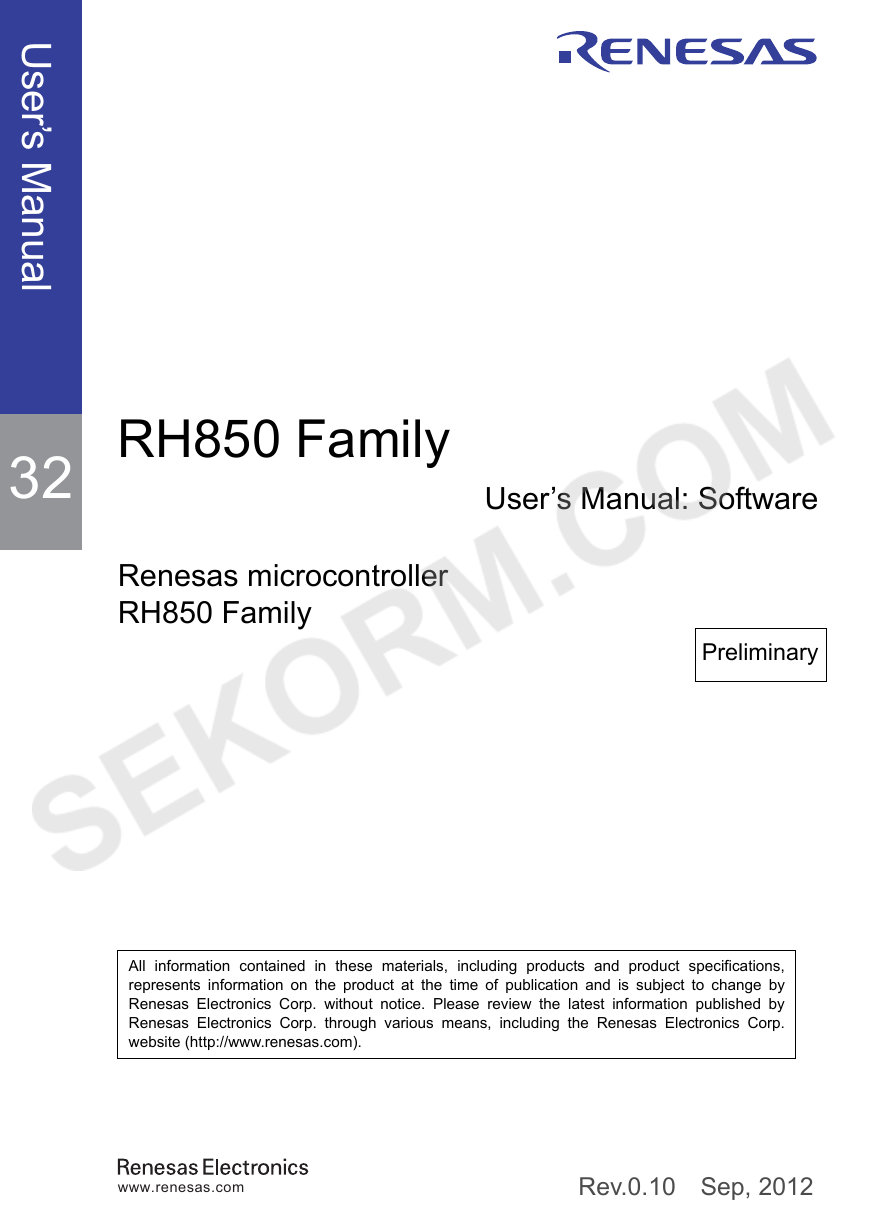
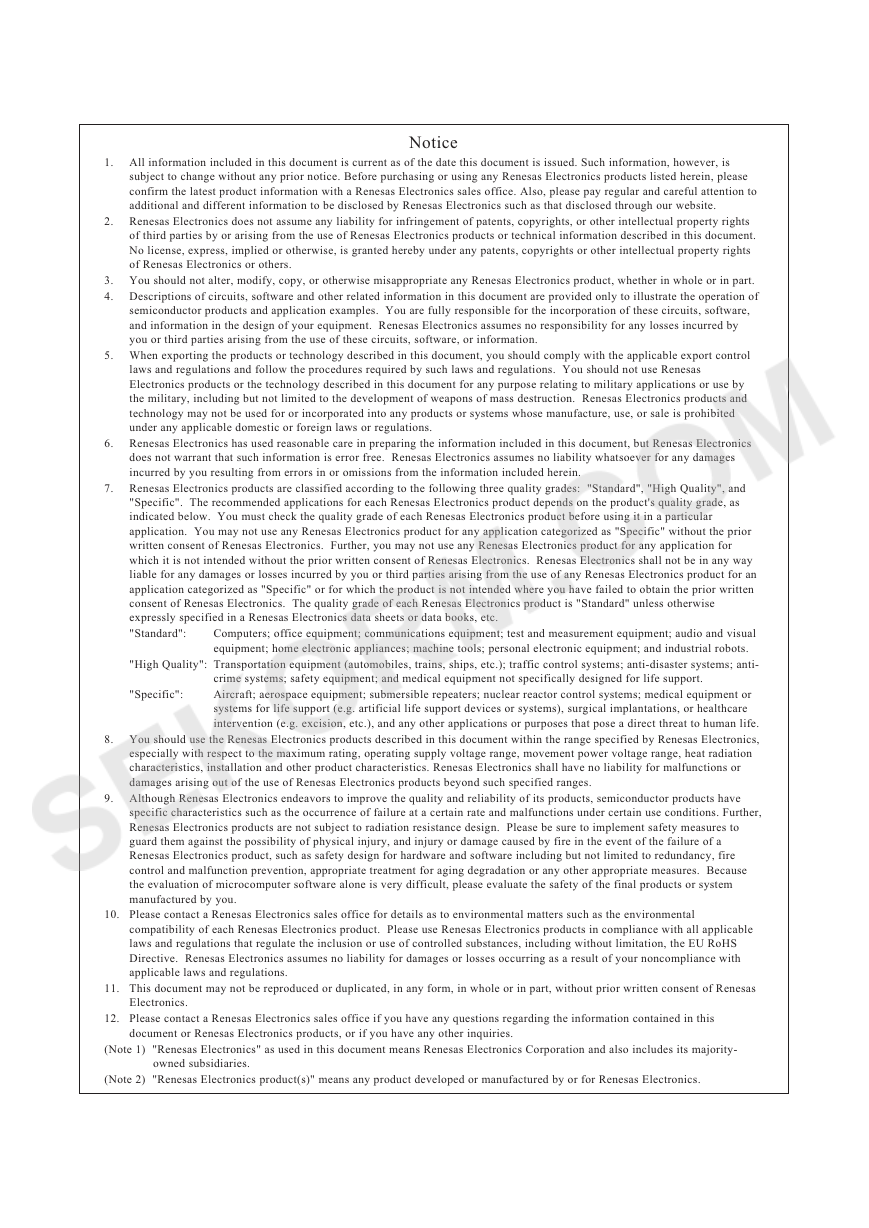
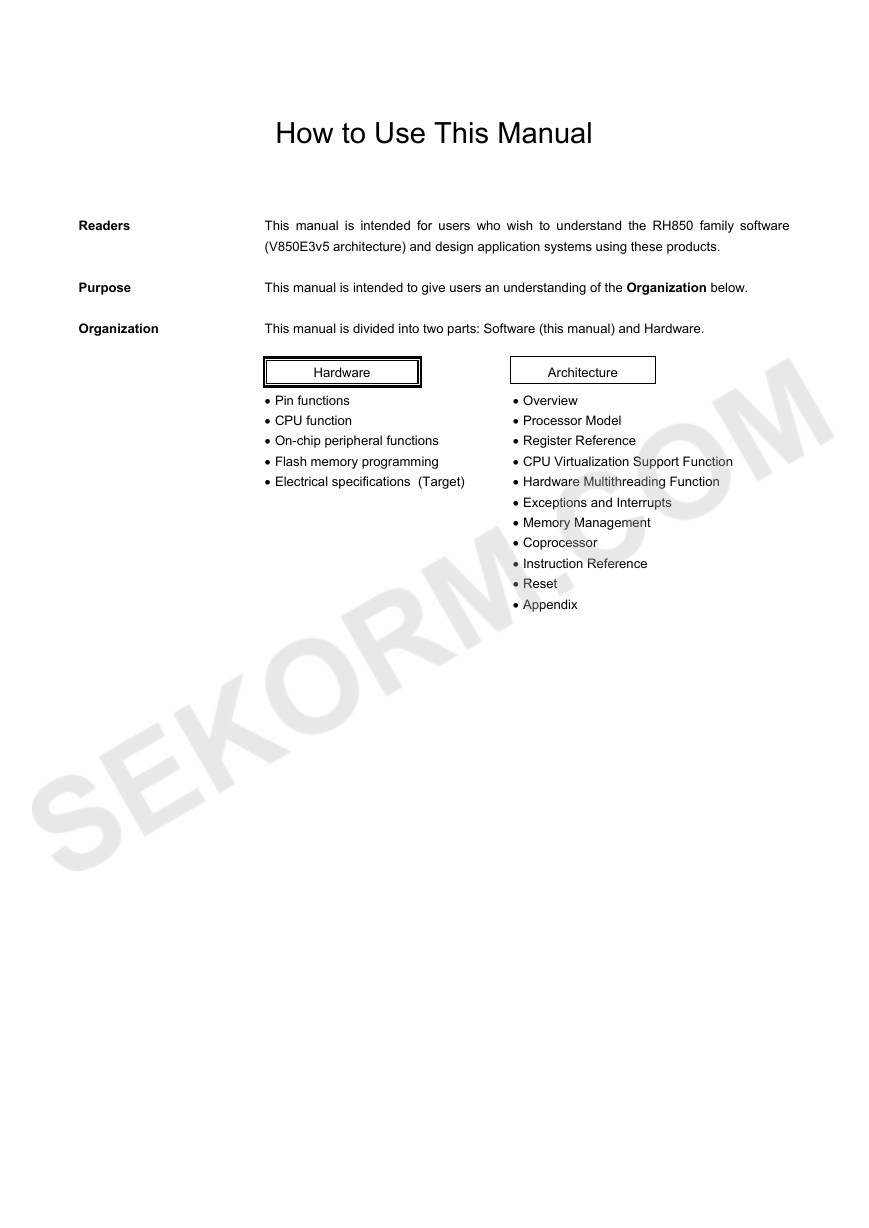

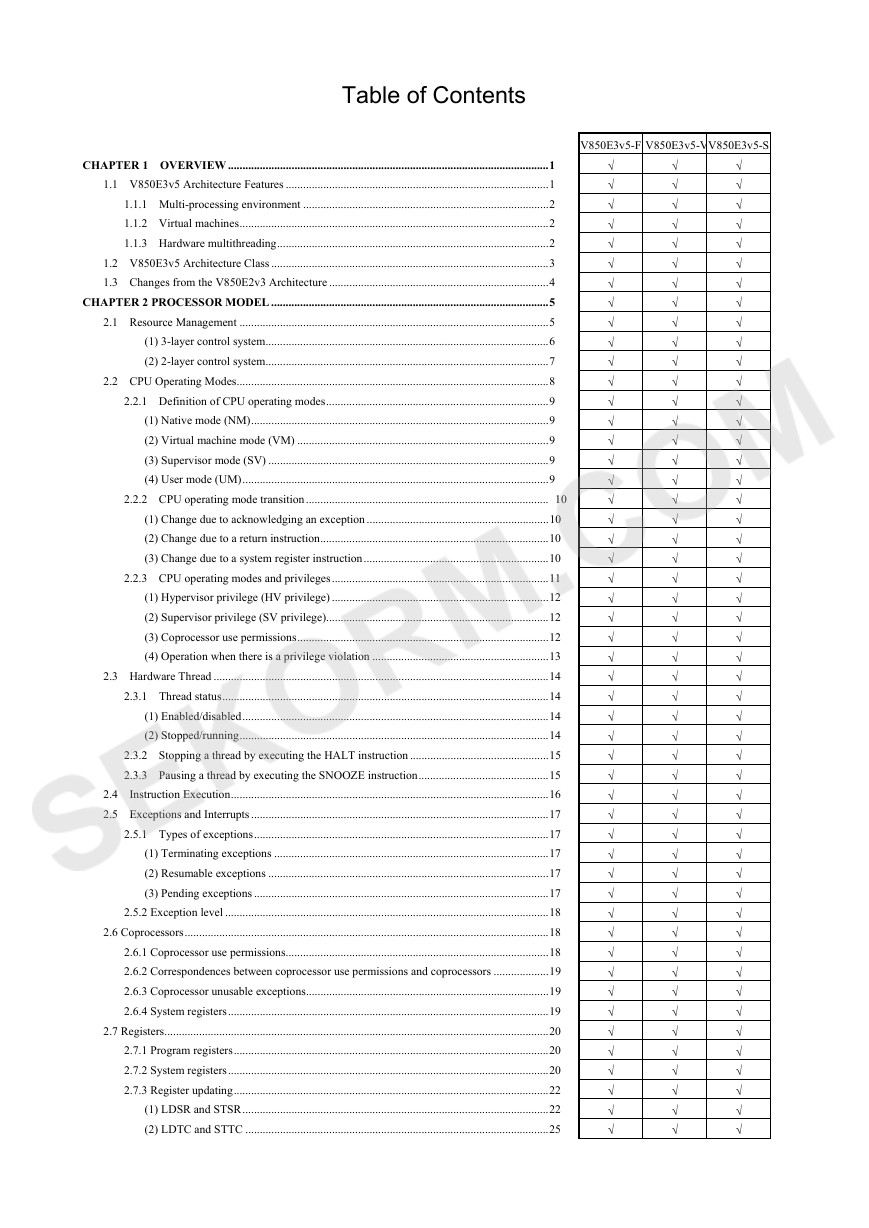
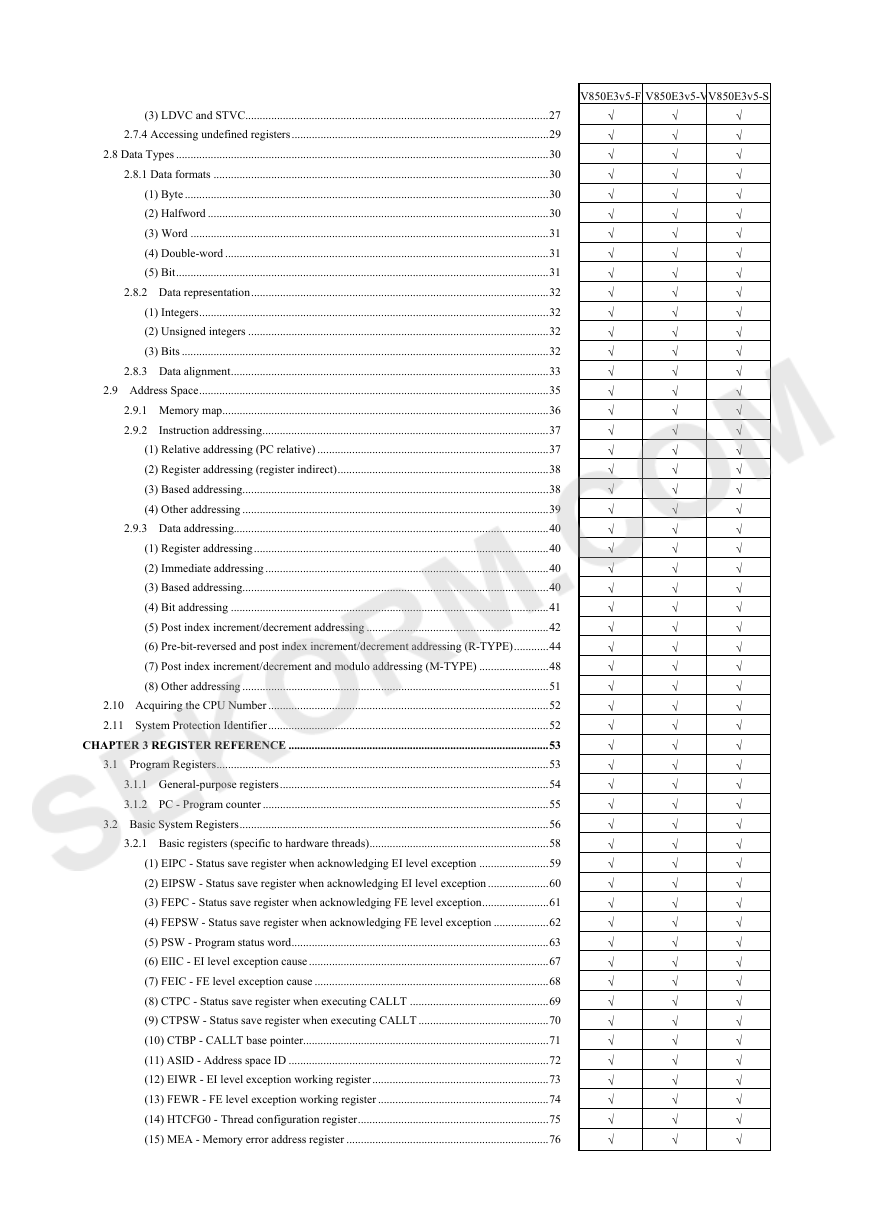
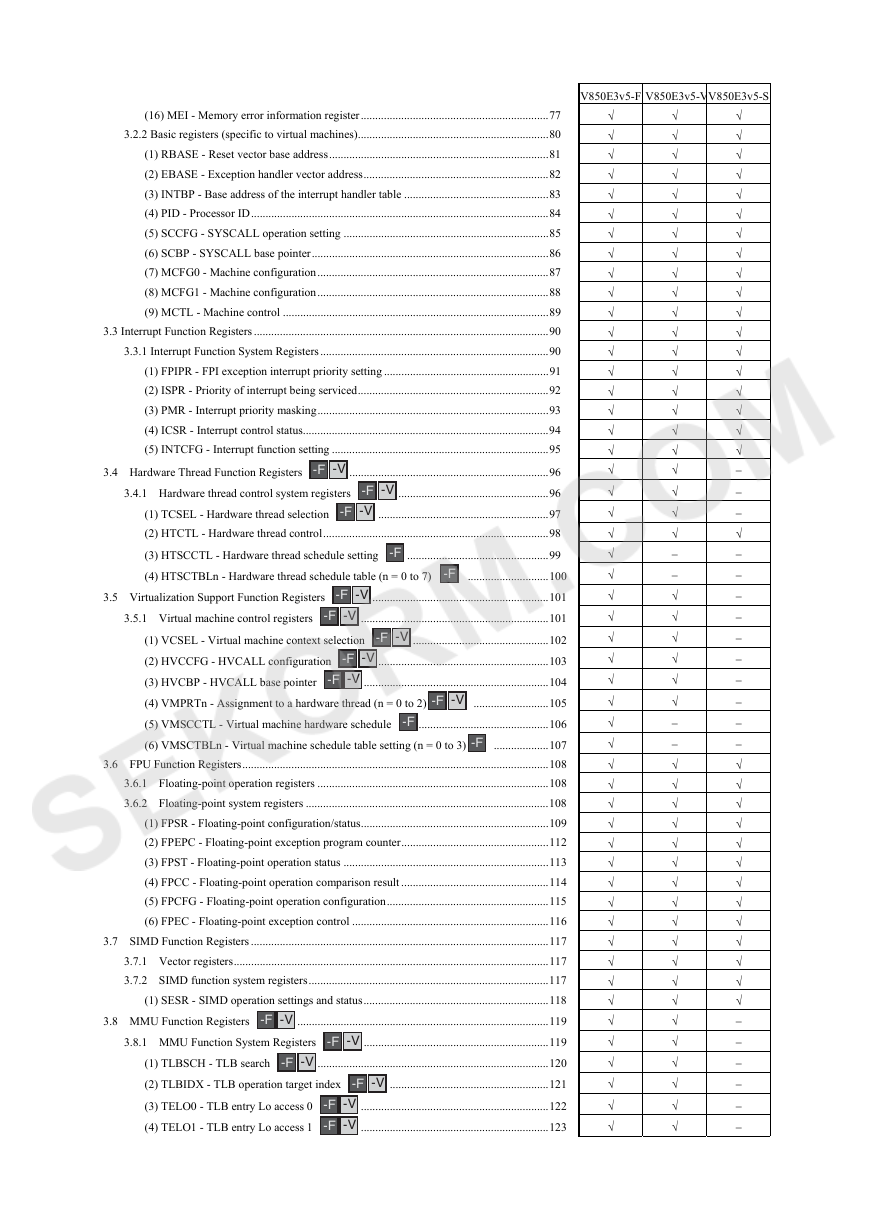
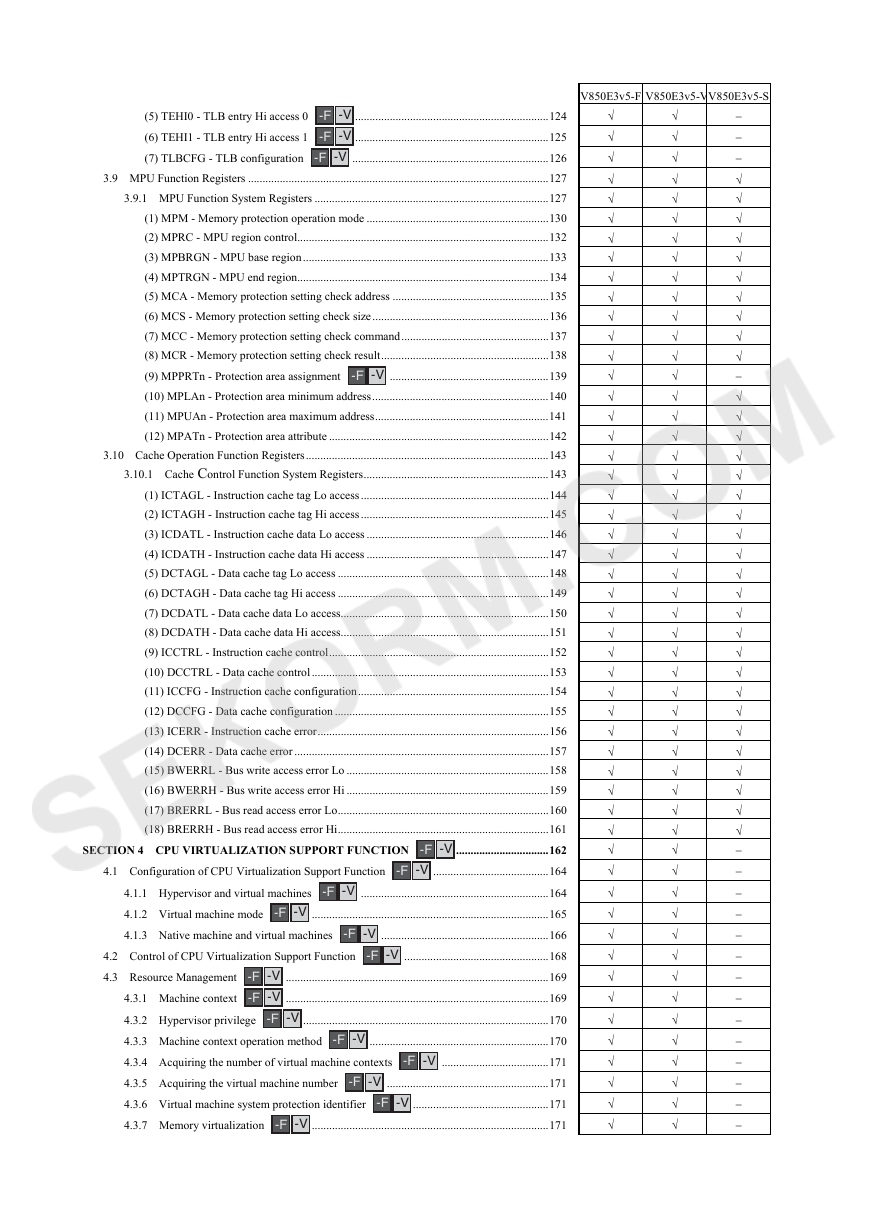








 2023年江西萍乡中考道德与法治真题及答案.doc
2023年江西萍乡中考道德与法治真题及答案.doc 2012年重庆南川中考生物真题及答案.doc
2012年重庆南川中考生物真题及答案.doc 2013年江西师范大学地理学综合及文艺理论基础考研真题.doc
2013年江西师范大学地理学综合及文艺理论基础考研真题.doc 2020年四川甘孜小升初语文真题及答案I卷.doc
2020年四川甘孜小升初语文真题及答案I卷.doc 2020年注册岩土工程师专业基础考试真题及答案.doc
2020年注册岩土工程师专业基础考试真题及答案.doc 2023-2024学年福建省厦门市九年级上学期数学月考试题及答案.doc
2023-2024学年福建省厦门市九年级上学期数学月考试题及答案.doc 2021-2022学年辽宁省沈阳市大东区九年级上学期语文期末试题及答案.doc
2021-2022学年辽宁省沈阳市大东区九年级上学期语文期末试题及答案.doc 2022-2023学年北京东城区初三第一学期物理期末试卷及答案.doc
2022-2023学年北京东城区初三第一学期物理期末试卷及答案.doc 2018上半年江西教师资格初中地理学科知识与教学能力真题及答案.doc
2018上半年江西教师资格初中地理学科知识与教学能力真题及答案.doc 2012年河北国家公务员申论考试真题及答案-省级.doc
2012年河北国家公务员申论考试真题及答案-省级.doc 2020-2021学年江苏省扬州市江都区邵樊片九年级上学期数学第一次质量检测试题及答案.doc
2020-2021学年江苏省扬州市江都区邵樊片九年级上学期数学第一次质量检测试题及答案.doc 2022下半年黑龙江教师资格证中学综合素质真题及答案.doc
2022下半年黑龙江教师资格证中学综合素质真题及答案.doc